
piston_damage
.pdf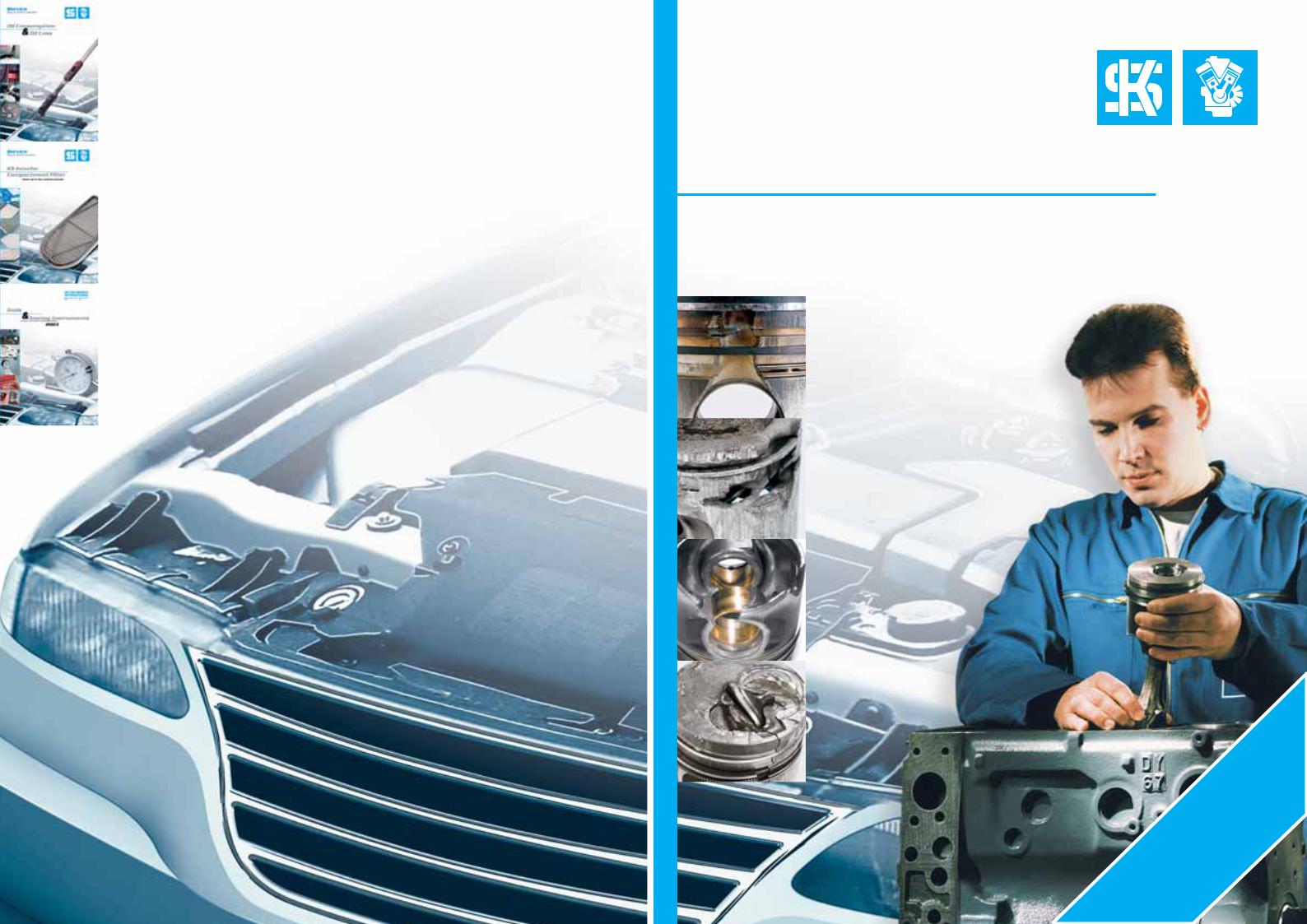
Service
Tips & Information
Piston damages
Recognising and rectifying
|
|
|
omPractice“ |
|
|
|
|
||
|
|
|
||
|
|
|
||
|
|
|
||
|
|
The |
new |
|
|
|
for |
||
|
|
„Fr |
|
|

Piston damages
Imprint / Table of contents
Date 08.04
1. Edition
Part-No. 50 003 973-02
Published by:
© MSI Motor Service International GmbH Untere Neckarstraße
D-74172 Neckarsulm
Editors:
Uwe Schilling
Alexander Schäfer
Authors:
Bernd Waldhauer
Uwe Schilling
Simon Schnaibel
Johann Szopa
Technical Contributors:
Andreas Bühl
Jean-Pierre Brigaud
Bernd Greiner
Mike Knowles
Karl Leitgeb
Uwe Scherzer
Graphical design and production:
Margot Schneider Uwe Schilling
Hela Werbung GmbH, Heilbronn | Germany
This document must not be reprinted, duplicated or translated in full or in part without our prior written consent and without reference to the source of the material.
All content including pictures and diagrams is subject to alteration.
We accept no liability.
1. |
Introduction........................................................................................ |
4 |
|
|
1.1 |
Preface ......................................................................................... |
4 |
|
1.2 |
Notes on using this brochure ........................................................ |
5 |
2. |
Quick diagnosis.................................................................................. |
6 |
|
3. |
Detailed descriptions of the different types of damages 10 |
||
|
3.1 |
Seizure due to insufficient clearances ................................ |
10 |
|
3.1.0 |
General information about seizures due to insufficient clearances .. |
10 |
|
3.1.1 |
Seizure on the piston skirt due to insufficient clearance ............. |
11 |
3.1.2Seizure due to insufficient clearances next to the
|
piston pin bores (45° seizure marks)............................................ |
12 |
3.1.3 |
Seizure due to insufficient clearances at the lower end of the skirt .. |
14 |
3.2 |
Seizure due to lack of lubrication ....................................... |
16 |
3.2.0 |
General information about seizure due to lack of lubrication ...... |
16 |
3.2.1 |
Seizure due to lack of lubrication on the piston skirt................... |
17 |
3.2.2Piston skirt seizure on one side only
|
without matching areas on the counterpressure side .................. |
18 |
3.2.3 Dry running damage due to lack of lubrication |
|
|
|
caused by fuel flooding............................................................... |
20 |
3.2.4 |
Piston top land seizure on a piston from a diesel engine............. |
21 |
3.2.5 Seizure due to lack of lubrication caused by scuffed piston rings .... |
22 |
|
3.3 |
Seizures due to overheating.................................................. |
24 |
3.3.0 |
General information on seizures due to overheating ................... |
24 |
3.3.1Seizure due to overheating centered around the piston top land.25
3.3.2 |
Seizure due to overheating centered around the piston skirt ...... |
26 |
3.4 |
Damages due to abnormal combustion ................................ |
27 |
3.4.0General information about piston damage
due to abnormal combustion ...................................................... |
27 |
3.4.1Removal of material by melting from the piston crown
|
and ring zone (gasoline/petrol engine)....................................... |
31 |
3.4.2 |
Material removal/fusion |
|
|
due to melting on the piston crown (diesel engine)..................... |
32 |
3.4.3 Cracks in the piston crown |
|
|
|
and piston combustion bowl (diesel engines)............................. |
34 |
3.4.4 |
Ring land fractures ..................................................................... |
36 |
3.4.5 Impact marks on the piston crown (diesel engine) ...................... |
38 |
|
3.4.6 Hole in the piston crown |
|
|
|
(gasoline/petrol engine)............................................................. |
40 |
3.4.7Piston top land seizure due to the use of incorrect pistons
(diesel engine)............................................................................ |
42 |
3.4.8Erosion on the piston top land
|
and on the piston crown (gasoline/petrol engine)......................... |
44 |
3.5 |
Piston and piston ring fractures ......................................... |
46 |
3.5.0 |
General information about piston fractures ................................ |
46 |
3.5.1 |
Piston fracture in the piston pin boss ......................................... |
47 |
3.5.2Piston fracture due to the mechanical contact between piston
crown and cylinder head............................................................. |
48 |
3.5.3 Material washout in the ring zone (ring fracture)......................... |
50 |
2 | Piston damages – Recognising and rectifying |
MSI Motor Service International |

Piston damages
Table of contents
3.6 |
Piston pin fractures............................................................... |
52 |
3.6.0 |
General information about piston pin fractures .......................... |
52 |
3.6.1 |
Fractured piston pin.................................................................... |
53 |
3.7 |
Damage to the piston pin Circlips ......................................... |
54 |
3.7.0 |
General information about damage to the piston pin circlips ...... |
54 |
3.7.1 |
Piston damage caused by broken piston pin circlips ................... |
55 |
3.8 |
Seizures in the piston pin bores............................................ |
58 |
3.8.0 |
General information about seizures in the piston pin bore.......... |
58 |
3.8.1 |
Seizure in the piston pin bore [floating-fit piston pin].................. |
59 |
3.8.2 |
Seizure in the piston pin bore [shrink-fit connecting rod] ............ |
60 |
3.8.3 |
Seizure in the piston pin bore [with piston skirt seizure(s)]......... |
61 |
3.9 |
Piston noises........................................................................... |
62 |
3.9.0 |
General information about piston noises .................................... |
62 |
3.9.1 |
Radial impact points on the piston top land................................ |
63 |
3.10 |
Cylinders and cylinder liners .............................................. |
64 |
3.10.1 |
Longitudinal cylinder liner cracks ............................................... |
65 |
3.10.2 |
Torn off flange on the cylinder liner............................................. |
66 |
3.10.3 |
Cavitation on cylinder liners ....................................................... |
68 |
3.10.4 |
Uneven cylinder wear.................................................................. |
70 |
3.10.5 |
Brightly polished areas in the upper part of the cylinder ............. |
72 |
3.10.6 |
Cylinder liner fracture due to hydraulic lock ................................ |
74 |
3.11 |
Increased oil consumption .................................................... |
76 |
3.11.0 |
General information on oil consumption ..................................... |
76 |
3.11.1 |
Incorrectly installed oil scraper ring |
|
|
(increased oil consumption after engine repairs) ........................ |
77 |
3.11.2Wear on pistons, piston rings and cylinder running surfaces
caused by the ingress of dirt (increased oil consumption) .......... |
78 |
3.11.3Wear on pistons, piston rings and cylinder running surfaces
caused by fuel flooding (increased oil consumption) .................. |
80 |
3.11.4Piston ring wear (soon after a major engine overhaul)
|
(increased oil consumption) ....................................................... |
82 |
3.11.5 |
Asymmetric piston wear pattern (increased oil consumption)..... |
84 |
4. Appendix............................................................................................... |
86 |
|
4.1 |
Glossary ..................................................................................... |
87 |
4.1.1 |
Technical terms and piston designations .................................... |
87 |
4.1.2 |
Explanation of the technical terms used in this document .......... |
88 |
4.2 |
Recommended Tools & Testing Instruments................................ |
97 |
4.3 |
Technical Brochures.................................................................. |
100 |
4.4MSI Training Programme —
For engine reconditioners ......................................................... |
102 |
4.5MSI Training Programme —
For workshops .......................................................................... |
103 |
MSI Motor Service International |
Piston damages – Recognising and rectifying | 3 |

Piston damages
Preface
1Introduction
1.1Preface
The requirements placed on the internal combustion have continuously changed throughout the history of its development. Although modern car manufacturers try to attract buyers with the latest improvements in terms of power output per litre, output torque, low fuel consumption and compliance with the newest exhaust emission standards, the primary concern of engine manufacturers has always been the durability and service life of the engines.
Since the fuel crisis in the 1970s, awareness has risen for the need to improve fuel economy, driving developments to reduce fuel consumption. As a result, the first fuel-in- jected petrol vehicles were introduced into series production, reducing fuel consumption and improving engine performance in the process.
Concerns for the environment became paramount in the 1980s. It was during this time that the most fundamental changes were made to the mixture formation process and the exhaust emission treatment. The use of catalytic converters for emission control and exhaust emission treatment on petrol engines meant that the mixture formation process needed to be made much more accurate and controllable. Existing fuel-injection systems were modified in order to comply with the increasingly strict emissions regulations, and were then expanded to include lambda control systems. This finally meant the end of the road for carburettors, as there was no way that they could fulfil the more stringent regulations. Although in the past the mixture formation process on diesel engines mostly utilised indirect injection techniques with mechanical
fuel-injection pumps, today’s diesel engines are equipped with direct injection systems with electronically controlled high-pressure fuel injection and turbocharging systems.
Another important development also dates back to the 1980s. With the increase in mobility and the associated increase in annual mileage covered by vehicles, it was inevitable that there would be a demand for longer service intervals. In order to ensure that the engines continued to operate safely and reliably between service intervals and to protect the sensitive catalytic converters against contamination with oil, it was necessary to reduce the engine’s consumption of oil and to adapt the quality of the engine oil to meet the increased requirements.
As part of these developments, the internal workings of the engines have also been further developed and modified on a continuous basis. Production processes in engine construction have been optimised, and production tolerances and the weight of the components have been lowered, whilst the quality of materials has been steadily improved. The shapes of the combustion chambers and the paths through which the combustion gases flow have been optimised in order to minimise fuel consumption and emissions.
Despite such substantial changes to the design of the engine, the types of damage which can be observed on the pistons and cylinders have
stayed remarkably similar. It is still the case that the main causes for engine damage are malfunctions, irregularities or excessive loads of a thermal
or mechanical nature. The results are
damages to those parts of the engine which are subjected to the increased loads, in a particular the pistons.
The aim of this brochure is to provide the interested reader with an overview of the different types of damages that can be encountered in the innermost part of an internal combustion engine, as well as to provide a useful tool for specialists
which will help to diagnose faults and determine their causes. The process of assessing engine damage is similar to a medical assessment in that it requires an all-encompassing approach to identify the cause(s) of a problem, which may not always be clear and obvious. It is not at all a rare occurrence for repairs to be carried out and then for the same damage to occur again and the same components to fail again because, although the damaged parts were replaced, nothing was done to eliminate the cause of the problem. For this reason a certain amount of “detective work” is always needed to track down the fault. In many cases the engineer is presented with just a faulty component, with
no information about how long the component was in service before it failed, or what the extent of the damage is. Naturally this makes it difficult to retrace how the fault happened, and the resulting diagnosis invariably offers a general, non damage-specific conclusion.
All of the types of damages covered in this new, fully revised edition have been put together with the utmost care and brought right up to date. It should provide you with a comprehensive source of information which will assist you in either your work or your studies.
4 | Piston damages – Recognising and rectifying |
MSI Motor Service International |
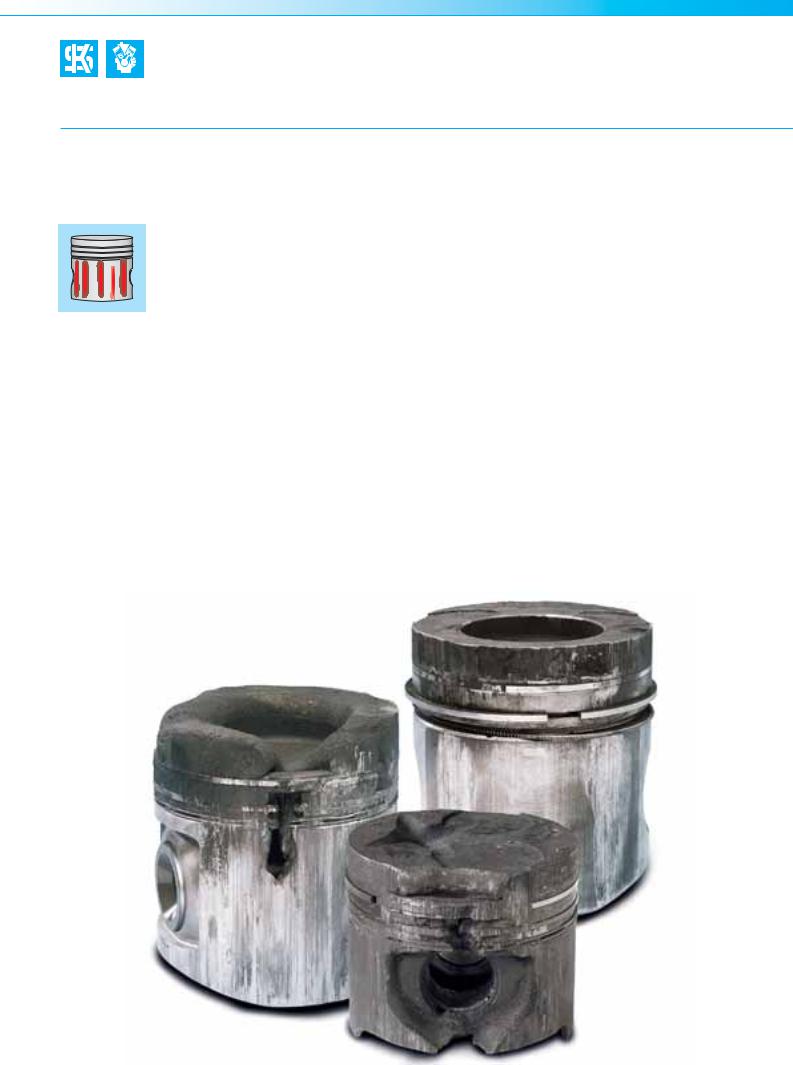
Piston damages
Preface
1.2 Notes on using this brochure
Recognising damage is not always a straightforward
task. In many cases the damage can be hard to make out in the photographs,
or it may not be immediately obvious that any damage is present. This is why in addition to the photographs showing the damage you will also see damage pictograms like the one opposite (Fig. 1). These will help you to recognise and identify the damage on the photographs more easily. These pictograms do not show the damage on a 1:1 scale. The pictograms are merely intended to serve as examples, in some cases with useful additional information.
The quick diagnosis pages are also new in this brochure. The aim of these
pages is help you to locate and assign the damage quickly. Here you will also find the above-mentioned damage pictograms which can be used as the basis for assigning faults to their causes, or for making at least a preliminary decision about what type of damage might be present.
In some cases there are several different pictograms for the same damage. If for example damage has occurred and left behind characteristic traces on the piston and on the running surface of the liner, then there may be two pictograms for this damage with both of the relevant components and their characteristic damage patterns.
A glossary has been included as an appendix with this brochure. This contains the key specialist terms used in the brochure, together with appropriate explanations.
A list of the tools recommended by MSI Motor Service International GmbH and overviews of other available brochures and the MSI training programme completes this edition.
We hope that this brochure will provide you with valuable information and not only help you to determine the cause of existing damage, but also to prevent future damage.
MSI Motor Service International GmbH
MSI Motor Service International |
Piston damages – Recognising and rectifying | 5 |

Piston damages
Quick diagnosis
Piston skirt seizing
Seizure on the piston skirt due to |
|
insufficient clearance ......................... |
11 |
Piston skirt seizure on one side |
|
only without matching areas on the |
|
counterpressure side.......................... |
18 |
Seizure due to lack of lubrication |
|
on the piston skirt .............................. |
17 |
Dry running damage due to lack of lubrication caused by fuel flooding.... 20
Seizure due to insufficient clearances |
|
next to the piston pin bores |
|
(45° seizure marks) ............................ |
12 |
Seizure due to overheating centered |
|
around the piston skirt ....................... |
26 |
Seizure due to insufficient clearances |
|
at the lower end of the skirt................ |
14 |
Wear on pistons, piston rings |
|
and cylinder running surfaces |
|
caused by fuel flooding |
|
(increased oil consumption) ............... |
80 |
Piston head seizing
Piston top land seizure on a piston |
|
Piston top land seizure due to the use |
from a diesel engine........................... |
21 |
of incorrect pistons (diesel engine) .... 42 |
Seizure due to overheating centered |
|
around the piston top land ................. |
25 |
Seizure due to lack of lubrication |
|
caused by scuffed piston rings........... |
22 |
|
|
|
|
|
|
|
|
|
|
6 | Piston damages – Recognising and rectifying |
|
MSI Motor Service International |
||
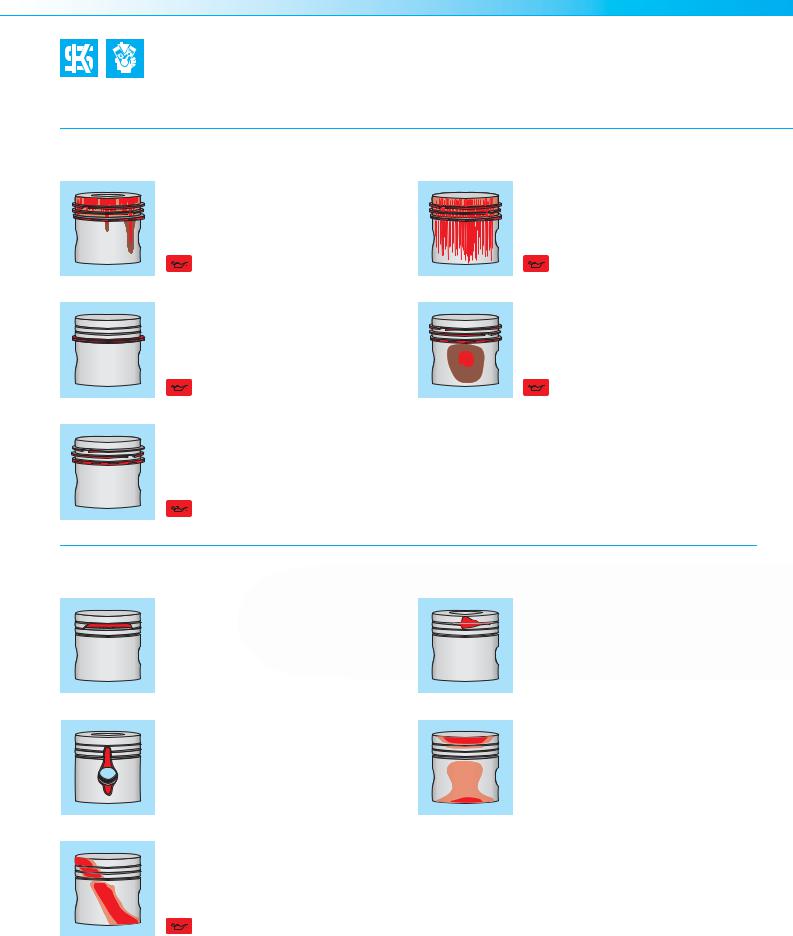
Piston damages
Quick diagnosis
Piston ring damages
Seizure due to lack of lubrication |
|
caused by scuffed piston rings........... |
22 |
Incorrectly installed oil scraper ring |
|
(increased oil consumption after |
|
engine repairs) ................................... |
77 |
Piston ring wear (soon after a major |
|
engine overhaul) (increased oil |
|
consumption) ..................................... |
82 |
Wear on pistons, piston rings and |
|
cylinder running surfaces caused by |
|
the ingress of dirt |
|
(increased oil consumption) ............... |
78 |
Wear on pistons, piston rings |
|
and cylinder running surfaces |
|
caused by fuel flooding |
|
(increased oil consumption) ............... |
80 |
Further damages in the ring and skirt Panel
Ring land fractures ............................. |
36 |
Material washout in the ring zone |
|
|
|
(ring fracture) ..................................... |
50 |
Piston damage caused by broken |
|
Radial impact points on the piston |
|
piston pin circlips ............................... |
55 |
top land.............................................. |
63 |
Asymmetric piston wear pattern |
|
(increased oil consumption) ............... |
84 |
MSI Motor Service International |
Piston damages – Recognising and rectifying | 7 |
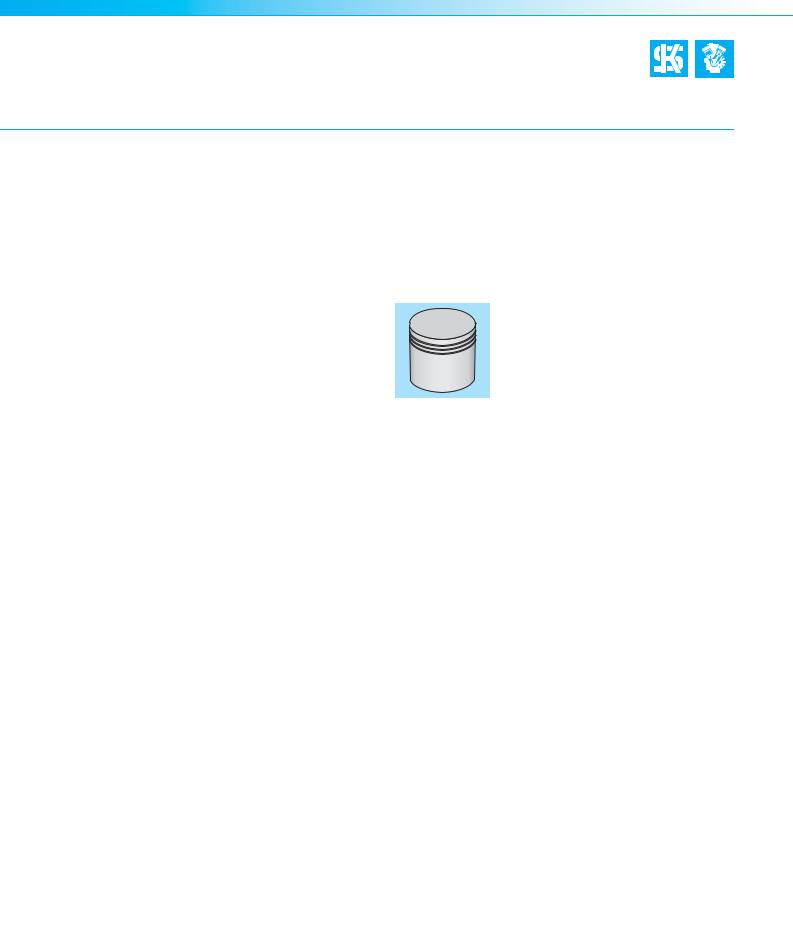
Piston damages
Quick diagnosis
Piston head damages
Removal of material by melting from |
|
the piston crown and ring zone |
|
(gasoline/petrol engine) .................... |
31 |
Hole in the piston crown |
|
(gasoline/petrol engine) .................... |
40 |
Piston fracture due to mechanical |
|
contact between the piston crown and |
|
the cylinder head................................ |
48 |
Cracks in the piston crown and piston |
|
combustion bowl (diesel engines) ...... |
34 |
Material removal/fusion due to melting on the piston crown (diesel engine).... 32
Erosion on the piston top land and |
|
on the piston crown (gasoline/petrol |
|
engine)............................................... |
44 |
Impact marks on the piston crown |
|
(diesel engine) ................................... |
38 |
Piston fracture in the piston pin boss . 47
Piston pin seizing & piston pin fractures
Seizure in the piston pin bore |
|
Seizure in the piston pin bore |
|
(with piston skirt seizure)................... |
61 |
(floating-fit piston pin)........................ |
59 |
Seizure in the piston pin bore |
Fractured piston pin ........................... |
53 |
(shrink-fit connecting rod) .................. |
60 |
|
|
|
|
|
8 | Piston damages – Recognising and rectifying |
MSI Motor Service International |
||
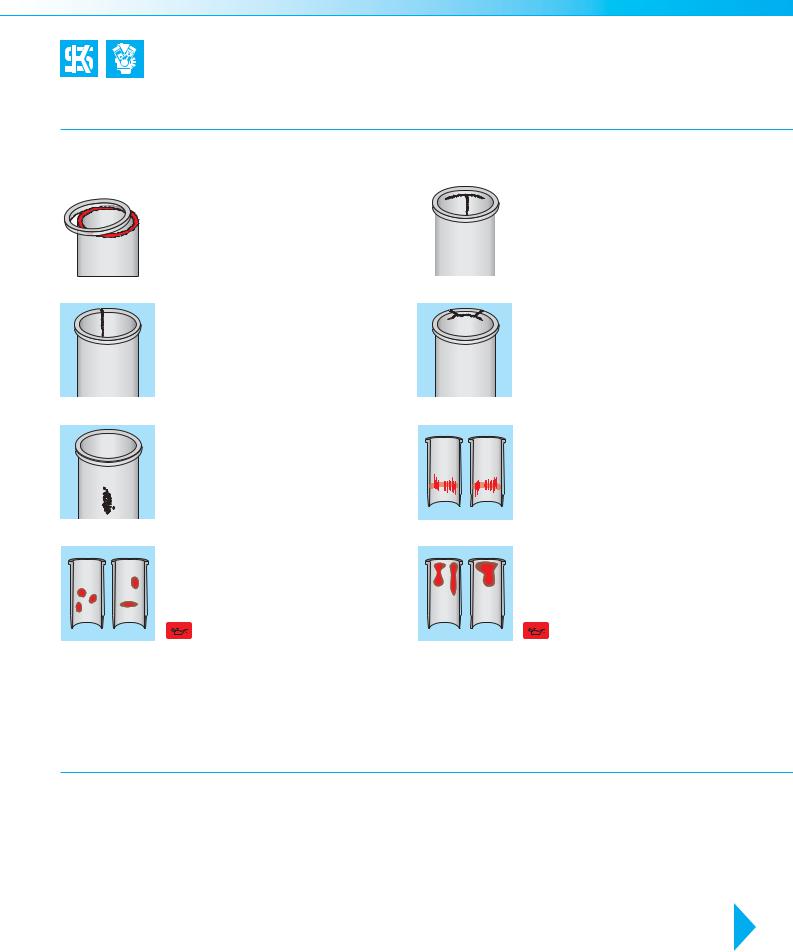
Piston damages
Quick diagnosis
Cylinder damages
|
....Torn off flange on the cylinder liner 66 |
|
|
|
....Torn off flange on the cylinder liner 66 |
|
|
|
|
|
|
|
|
|
|
|
|
Longitudinal cylinder liner cracks ....... |
65 |
Cylinder liner fracture due to |
|
|
|
hydraulic lock..................................... |
74 |
Cavitation on cylinder liners ............... |
68 |
Seizure due to insufficient clearances |
|
|
|
at the lower end of the skirt................ |
14 |
Uneven cylinder wear ......................... |
70 |
Brightly polished areas in the upper part |
|
|
|
of the cylinder .................................... |
72 |
Detailed descriptions of the different types of damages
MSI Motor Service International |
Piston damages – Recognising and rectifying | 9 |

Piston damages
Description – assessment – causes
3.1 Seizure due to insufficient clearances
3.1.0 General information about seizures due to insufficient clearances
In engine operation, the clearance between the piston and the cylinder may become reduced beyond permissible limits or even completely decimated as a result of incorrect dimensioning of the two sides, after cylinder distortion or after excessive thermal loads. In addition, the piston reaches much higher temperatures than the cylinder during engine operation, resulting in different thermal expansion behaviour of the piston and the cylinder. The thermal expansion of the piston is far greater than the cylinder which encloses it. In addition, the thermal expansion of aluminium materials is approximately twice that of grey cast iron, which needs to be taken into account accordingly at the design stage.
As the clearance between the piston and the cylinder starts to decrease, mixed friction occurs as a result of the oil film on the cylinder wall being forced away by the expanding piston. The initial result of this is that the load-bearing surfaces on the piston skirt are rubbed to a highly polished finish. The temperatures of the components increase further due to the mixed friction and the resulting frictional heat. In the process, the piston presses with increasing force against the cylinder wall and the oil film completely stops doing its job. The piston then starts to run dry in the cylinder, resulting in the first areas to show signs of wear due to rubbing,
with dark discoloration on the surface.
In summary, seizure due to insufficient clearances is typified by the following main characteristics:
highly polished pressure points which change gradually into darkly discoloured areas of wear due to rubbing. In the case of seizures due to insufficient clearances, the seizure points can be seen on both the pressure side and on the counterpressure side.
10 | Piston damages – Recognising and rectifying |
MSI Motor Service International |
